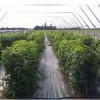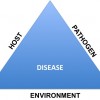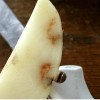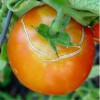 Vegetable and small fruit crop production under protective structures, such as greenhouses, high tunnels, and shade houses, often requires using soilless media to mitigate the impact of soilborne diseases, nematodes, and weeds, and it helps with management of fertilization and irrigation. Regardless of the nature and property of the media, they need to be held in containers to avoid direct contact with the soil or to elevate plants above the ground. An alternative to purchasing containers is building a soilless trench system for production of certain vegetables and small fruit crops. This 3-page fact sheet was written by Bielinski M. Santos and Teresa P. Salame-Donoso, and published by the UF Department of Horticultural Sciences, August 2012.
Vegetable and small fruit crop production under protective structures, such as greenhouses, high tunnels, and shade houses, often requires using soilless media to mitigate the impact of soilborne diseases, nematodes, and weeds, and it helps with management of fertilization and irrigation. Regardless of the nature and property of the media, they need to be held in containers to avoid direct contact with the soil or to elevate plants above the ground. An alternative to purchasing containers is building a soilless trench system for production of certain vegetables and small fruit crops. This 3-page fact sheet was written by Bielinski M. Santos and Teresa P. Salame-Donoso, and published by the UF Department of Horticultural Sciences, August 2012.
http://edis.ifas.ufl.edu/hs1204
Category: Crops
Solutions for Managing Wastewater in Florida Tomato Packinghouses (SL372/SS573)
 A large amount of wastewater is produced in Florida's packinghouses during the cleaning and sanitizing of tomatoes. High transportation costs for off-site disposal and strict surface water discharge regulations are critical issues associated with the management of this wastewater. This 4-page fact sheet provides solutions for increasing the reuse of wastewater in tomato packinghouses in Florida. Written by Gurpal Toor, Maninder Chahal, and Bielinski Santos, and published by the UF Department of Soil and Water Science, August 2012.
A large amount of wastewater is produced in Florida's packinghouses during the cleaning and sanitizing of tomatoes. High transportation costs for off-site disposal and strict surface water discharge regulations are critical issues associated with the management of this wastewater. This 4-page fact sheet provides solutions for increasing the reuse of wastewater in tomato packinghouses in Florida. Written by Gurpal Toor, Maninder Chahal, and Bielinski Santos, and published by the UF Department of Soil and Water Science, August 2012.
http://edis.ifas.ufl.edu/ss573
Integrated Disease Management for Vegetable Crops in Florida (PP193/PP111)
 Integrated Pest Management (IPM) as applied to vegetable diseases means using all the tactics available to the grower (cultural, biological, host-plant resistance, field scouting, chemical) that provide acceptable yield and quality at the least cost and are compatible with the tenets of environmental stewardship. This 6-page fact sheet was written by Mathews Paret, Nick Dufault, Tim Momol, Jim Marois, and Steve Olson, and published by the UF Department of Plant Pathology, August 2012.
Integrated Pest Management (IPM) as applied to vegetable diseases means using all the tactics available to the grower (cultural, biological, host-plant resistance, field scouting, chemical) that provide acceptable yield and quality at the least cost and are compatible with the tenets of environmental stewardship. This 6-page fact sheet was written by Mathews Paret, Nick Dufault, Tim Momol, Jim Marois, and Steve Olson, and published by the UF Department of Plant Pathology, August 2012.
http://edis.ifas.ufl.edu/pp111
Potato Physiological Disorders – Internal Heat Necrosis (HS1145/HS395)
 Internal heat necrosis is a physiological disorder that causes an unacceptable browning of the tuber tissue and can cause economic losses to the grower. The three leading suspected causes of IHN in tubers are high soil temperature, inadequate soil moisture, and suboptimal plant nutrition, or a combination of these factors. This 3-page fact sheet was written by Lincoln Zotarelli, Christine M. Worthington,Chad M. Hutchinson, Seth Byrd, Douglas Gergela, and Diane Rowland, and published by the UF Department of Horticultural Sciences, July 2012. http://edis.ifas.ufl.edu/hs395
Internal heat necrosis is a physiological disorder that causes an unacceptable browning of the tuber tissue and can cause economic losses to the grower. The three leading suspected causes of IHN in tubers are high soil temperature, inadequate soil moisture, and suboptimal plant nutrition, or a combination of these factors. This 3-page fact sheet was written by Lincoln Zotarelli, Christine M. Worthington,Chad M. Hutchinson, Seth Byrd, Douglas Gergela, and Diane Rowland, and published by the UF Department of Horticultural Sciences, July 2012. http://edis.ifas.ufl.edu/hs395
Identification and Control of Johnsongrass, Vaseygrass, and Guinea Grass in Pastures (SSAGR363/AG372)
 Johnsongrass is a common weed throughout the South and Midwest. People often incorrectly call any weed johnsongrass, but it is one of three grasses found in Florida pastures. Knowing the differences between johnsongrass, vaseygrass, and guinea grass will help with proper weed management. This 3-page fact sheet was written by H. Smith, J. Ferrell, and B. Sellers, and published by the UF Agronomy Department, August 2012. http://edis.ifas.ufl.edu/ag372
Johnsongrass is a common weed throughout the South and Midwest. People often incorrectly call any weed johnsongrass, but it is one of three grasses found in Florida pastures. Knowing the differences between johnsongrass, vaseygrass, and guinea grass will help with proper weed management. This 3-page fact sheet was written by H. Smith, J. Ferrell, and B. Sellers, and published by the UF Agronomy Department, August 2012. http://edis.ifas.ufl.edu/ag372
Agricultural Management Options for Climate Variability and Change: Sod-Based Rotation (AE492)
 A sod-based rotation is when a producer adapts a conventional peanut/cotton rotation by growing a perennial grass, such as bahiagrass, during two years of the rotation. The perennial grass can be grazed, cut for hay or harvested for seed for additional income. Using a sod-based rotation can improve soil water-holding capacity and potentially reduce impacts of dry spells and droughts. This 4-page fact sheet was written by David Wright, Jim Marois, Clyde Fraisse, and Daniel Dourte, and published by the UF Department of Agricultural and Biological Engineering, August 2012. http://edis.ifas.ufl.edu/ae492
A sod-based rotation is when a producer adapts a conventional peanut/cotton rotation by growing a perennial grass, such as bahiagrass, during two years of the rotation. The perennial grass can be grazed, cut for hay or harvested for seed for additional income. Using a sod-based rotation can improve soil water-holding capacity and potentially reduce impacts of dry spells and droughts. This 4-page fact sheet was written by David Wright, Jim Marois, Clyde Fraisse, and Daniel Dourte, and published by the UF Department of Agricultural and Biological Engineering, August 2012. http://edis.ifas.ufl.edu/ae492
Agricultural Management Options for Climate Variability and Change: AgroClimate (AE491)
 AgroClimate is a website providing climate information and decision-support tools to producers throughout the Southeastern United States. With information from the site, producers can develop a strategy for the coming season and track climate conditions that affect crop development and yield. This 4-page fact sheet was written by Clyde Fraisse, and published by the UF Department of Agricultural and Biological Engineering, August 2012. http://edis.ifas.ufl.edu/ae491
AgroClimate is a website providing climate information and decision-support tools to producers throughout the Southeastern United States. With information from the site, producers can develop a strategy for the coming season and track climate conditions that affect crop development and yield. This 4-page fact sheet was written by Clyde Fraisse, and published by the UF Department of Agricultural and Biological Engineering, August 2012. http://edis.ifas.ufl.edu/ae491
Phosphorus Fertilizer Recommendations for Sugarcane Production on Florida Organic Soils (SSAGR348/SC091)
 Much of the sugarcane grown in South Florida is on organic soils in the Everglades Agricultural Area, which is a phosphorus-limited system. Phosphorus loads in drainage water in the Everglades Agricultural Area are an environmental concern so it is important for sugarcane growers to use best management practices such as soil testing and to follow fertilizer recommendations. This document contains updated UF/IFAS phosphorus fertilizer recommendations for Florida organic soils. This 7-page fact sheet was written by J. Mabry McCray, Ronald W. Rice, and Alan L. Wright, and published by the UF Department of Agronomy, July 2012. http://edis.ifas.ufl.edu/sc091
Much of the sugarcane grown in South Florida is on organic soils in the Everglades Agricultural Area, which is a phosphorus-limited system. Phosphorus loads in drainage water in the Everglades Agricultural Area are an environmental concern so it is important for sugarcane growers to use best management practices such as soil testing and to follow fertilizer recommendations. This document contains updated UF/IFAS phosphorus fertilizer recommendations for Florida organic soils. This 7-page fact sheet was written by J. Mabry McCray, Ronald W. Rice, and Alan L. Wright, and published by the UF Department of Agronomy, July 2012. http://edis.ifas.ufl.edu/sc091
Postharvest Quality and Decay Incidence among Tomato Fruit as Affected by Weather and Cultural Practices. (PP294)
 Postharvest decay losses for field-grown, fresh-market tomatoes are usually associated with harvests that occur when fields are wet and warm. During periods of persistently wet fields, decay pathogens infect damaged fruit on the plant as well as injuries to petioles and stems. Review of all reports and photos implicated excessive water in fruit rather than air temperatures as the primary predisposition. Excessive water in fruit is possible at virtually any time of the season and can appear at times of cold as well as warm field temperatures. This 8-page fact sheet was written by Jerry A. Bartz, Steven A. Sargent, and John W. Scott, and published by the UF Department of Plant Pathology, July 2012.
Postharvest decay losses for field-grown, fresh-market tomatoes are usually associated with harvests that occur when fields are wet and warm. During periods of persistently wet fields, decay pathogens infect damaged fruit on the plant as well as injuries to petioles and stems. Review of all reports and photos implicated excessive water in fruit rather than air temperatures as the primary predisposition. Excessive water in fruit is possible at virtually any time of the season and can appear at times of cold as well as warm field temperatures. This 8-page fact sheet was written by Jerry A. Bartz, Steven A. Sargent, and John W. Scott, and published by the UF Department of Plant Pathology, July 2012.
http://edis.ifas.ufl.edu/pp294
Blossom Drop, Reduced Fruit Set, and Post-Pollination Disorders in Tomato (HS1195)
 Blossom drop and reduced fruit set in tomato can seriously impact yields. Growers in Florida routinely experience such problems and inquire about the cause and possible preventative measures to reduce flower loss and improve yields. The problem can be frustrating and difficult to manage in some situations. This 6-page fact sheet was written by Monica Ozores-Hampton, Fnu Kiran, and Gene McAvoy, and published by the UF Department of Horticultural Sciences, July 2012.
Blossom drop and reduced fruit set in tomato can seriously impact yields. Growers in Florida routinely experience such problems and inquire about the cause and possible preventative measures to reduce flower loss and improve yields. The problem can be frustrating and difficult to manage in some situations. This 6-page fact sheet was written by Monica Ozores-Hampton, Fnu Kiran, and Gene McAvoy, and published by the UF Department of Horticultural Sciences, July 2012.
http://edis.ifas.ufl.edu/hs1195
Agricultural Management Options for Climate Variability and Change: Variable-Rate Irrigation (AE490)
 Most fields are not uniform because of natural variations in soil type or topography. When water is applied uniformly to a field, some areas of the field may be overwatered while other areas may remain too dry. Variable-rate irrigation technology gives farmers an automated method to vary rates of irrigation water based on the individual management zones within a field and avoid irrigating roadways, waterways, wetlands, and other non-farmed areas within a pivot. This 3-page fact sheet was written by Calvin Perry, Clyde Fraisse, and Daniel Dourte, and published by the UF Department of Agricultural and Biological Engineering, July 2012.
Most fields are not uniform because of natural variations in soil type or topography. When water is applied uniformly to a field, some areas of the field may be overwatered while other areas may remain too dry. Variable-rate irrigation technology gives farmers an automated method to vary rates of irrigation water based on the individual management zones within a field and avoid irrigating roadways, waterways, wetlands, and other non-farmed areas within a pivot. This 3-page fact sheet was written by Calvin Perry, Clyde Fraisse, and Daniel Dourte, and published by the UF Department of Agricultural and Biological Engineering, July 2012.
http://edis.ifas.ufl.edu/ae490
A Stink Bug Euschistus quadrator Rolston (Insecta: Hemiptera: Pentatomidae) (EENY523/IN937)
 Euschistus quadrator, like other stink bugs, is highly polyphagous. It is found on weeds such as clover, vetch and other legumes. It feeds on many different crops, though it is primarily found on cotton, soybeans and corn. Stink bugs cause injury to various fruits and vegetables by feeding, resulting in significant quality and yield loss. They have piercing-sucking mouthparts and most feed primarily on fruits and seeds. This 5-page fact sheet was written by Sara A. Brennan, Joseph Eger, and Oscar E. Liburd, and published by the UF Department of Entomology and Nematology, June 2012.
Euschistus quadrator, like other stink bugs, is highly polyphagous. It is found on weeds such as clover, vetch and other legumes. It feeds on many different crops, though it is primarily found on cotton, soybeans and corn. Stink bugs cause injury to various fruits and vegetables by feeding, resulting in significant quality and yield loss. They have piercing-sucking mouthparts and most feed primarily on fruits and seeds. This 5-page fact sheet was written by Sara A. Brennan, Joseph Eger, and Oscar E. Liburd, and published by the UF Department of Entomology and Nematology, June 2012.
http://edis.ifas.ufl.edu/in937
Agricultural Management Options for Climate Variability and Change: Sensor-Based, Variable-Rate Nitrogen Management (AE487)
 Nitrogen fertilizer cost represents about 10%–15% of total farm costs for corn, cotton, and wheat in the Southeastern United States. The efficiency of nitrogen use can be highly variable for producers, so a sensor-based, variable-rate nitrogen application (SVNA) system has been developed for irrigated and dryland row crops to reduce production costs. Using sensor-based N application, there is a minimum 20% reduction in N usage. If that rate reduction were applied to all the cotton, corn, and wheat grown in the United States, CO2 emissions from N fertilizer production would be decreased by 2.7 million tons.
Nitrogen fertilizer cost represents about 10%–15% of total farm costs for corn, cotton, and wheat in the Southeastern United States. The efficiency of nitrogen use can be highly variable for producers, so a sensor-based, variable-rate nitrogen application (SVNA) system has been developed for irrigated and dryland row crops to reduce production costs. Using sensor-based N application, there is a minimum 20% reduction in N usage. If that rate reduction were applied to all the cotton, corn, and wheat grown in the United States, CO2 emissions from N fertilizer production would be decreased by 2.7 million tons.
This 4-page fact sheet was written by Wesley Porter, Ahmad Khalilian, Daniel Dourte, and Clyde Fraisse, and published by the UF Department of Agricultural and Biological Engineering, July 2012.
http://edis.ifas.ufl.edu/ae487
Wasp Parasitoid Doryctobracon areolatus (Szépligeti) (Insecta: Hymenoptera: Braconidae) (EENY525/IN938)
 Doryctobracon areolatus was introduced into Florida and the Dominican Republic for control of the Caribbean fruit fly and the West Indian fruit fly. In its native habitats, parasitism of fruit flies in certain fruit can reach more than 80%. Mean parasitism of Caribbean fruit fly following original establishment in Florida was around 40%. This 4-page fact sheet was written by Charles Stuhl and John Sivinski, and published by the UF Department of Entomology and Nematology, June 2012.
Doryctobracon areolatus was introduced into Florida and the Dominican Republic for control of the Caribbean fruit fly and the West Indian fruit fly. In its native habitats, parasitism of fruit flies in certain fruit can reach more than 80%. Mean parasitism of Caribbean fruit fly following original establishment in Florida was around 40%. This 4-page fact sheet was written by Charles Stuhl and John Sivinski, and published by the UF Department of Entomology and Nematology, June 2012.
http://edis.ifas.ufl.edu/in938
Agricultural Management Options for Climate Variability and Change: Microirrigation (HS1203)
 Microirrigation is the slow, frequent application of water directly to relatively small areas adjacent to individual plants through emitters placed along a water delivery line. A leading advantage of microirrigation is that evaporation that does not contribute to plant growth much less than with sprinkler irrigation. This 5-page fact sheet was written by Lincoln Zotarelli, Clyde Fraisse, and Daniel Dourte, and published by the UF Department of Horticultural Sciences, July 2012.
Microirrigation is the slow, frequent application of water directly to relatively small areas adjacent to individual plants through emitters placed along a water delivery line. A leading advantage of microirrigation is that evaporation that does not contribute to plant growth much less than with sprinkler irrigation. This 5-page fact sheet was written by Lincoln Zotarelli, Clyde Fraisse, and Daniel Dourte, and published by the UF Department of Horticultural Sciences, July 2012.
http://edis.ifas.ufl.edu/hs1203
Growth, Reduction, and Survival of Bacteria on Melon Types (FSHN1207/FS191)
 From 1990 to 2000, over 700 cases of foodborne illness were associated with outbreaks due to melon consumption in the U.S. and Canada. Even with efforts to educate industry and consumers of safe produce-handling practices, in the last decade there were still over 1,100 documented illnesses associated with melon consumption. This 45-page fact sheet highlights the research that has been done to provide insight on possible sanitation methods and their efficacy in decontaminating melon types of foodborne pathogens as well as natural microflora. Written by Thao P. Nguyen, Michelle D. Danyluk, and Keith R. Schneider, and published by the UF Department of Food Science and Human Nutrition, May 2012.
From 1990 to 2000, over 700 cases of foodborne illness were associated with outbreaks due to melon consumption in the U.S. and Canada. Even with efforts to educate industry and consumers of safe produce-handling practices, in the last decade there were still over 1,100 documented illnesses associated with melon consumption. This 45-page fact sheet highlights the research that has been done to provide insight on possible sanitation methods and their efficacy in decontaminating melon types of foodborne pathogens as well as natural microflora. Written by Thao P. Nguyen, Michelle D. Danyluk, and Keith R. Schneider, and published by the UF Department of Food Science and Human Nutrition, May 2012.
http://edis.ifas.ufl.edu/fs191
Western Leaffooted Bug Leptoglossus zonatus (Dallas) (Insecta: Hemiptera: Coreidae) (EENY517/IN935)
 Leptoglossus zonatus feeds on the satsuma mandarin by inserting its piercing-sucking mouthparts in the fruit and releasing a toxic substance. It transmits a trypanosomatid plant pathogen similar to the one that causes Chagas’ disease and sleeping sickness in humans, but that is only pathogenic to plants. This 4-page fact sheet was written by Amelio A. Chi and Russell F. Mizell III, and published by the UF Department of Entomology and Nematology, June 2012.
Leptoglossus zonatus feeds on the satsuma mandarin by inserting its piercing-sucking mouthparts in the fruit and releasing a toxic substance. It transmits a trypanosomatid plant pathogen similar to the one that causes Chagas’ disease and sleeping sickness in humans, but that is only pathogenic to plants. This 4-page fact sheet was written by Amelio A. Chi and Russell F. Mizell III, and published by the UF Department of Entomology and Nematology, June 2012.
http://edis.ifas.ufl.edu/in935
How to Reduce Clogging Problems in Fertigation (HS1202)
 Fertigation is the process of applying fertilizers through an irrigation system by injecting them into the water. Because of its effectiveness and efficiency, fertigation is widely used in vegetable and fruit production. However, clogging of lines and emitters may become a problem. This 7-page fact sheet provides practical suggestions for better fertigation management so growers can reduce clogging problems. Written by Guodong Liu and Gene McAvoy, and published by the UF Department of Horticultural Sciences, June 2012.
Fertigation is the process of applying fertilizers through an irrigation system by injecting them into the water. Because of its effectiveness and efficiency, fertigation is widely used in vegetable and fruit production. However, clogging of lines and emitters may become a problem. This 7-page fact sheet provides practical suggestions for better fertigation management so growers can reduce clogging problems. Written by Guodong Liu and Gene McAvoy, and published by the UF Department of Horticultural Sciences, June 2012.
http://edis.ifas.ufl.edu/hs1202
Weed Control in Carrot (HS201/WG026)
 Weeds reduce carrot yields by reducing the size of carrot roots through direct competition for nutrients, space, and water. Weeds also deform carrot roots, making them unmarketable. Weeds late in the season may also cause severe harvesting problems. This 3-page fact sheet was written by Peter J. Dittmar and William M. Stall, and published by the UF Department of Horticultural Sciences, June 2012.
Weeds reduce carrot yields by reducing the size of carrot roots through direct competition for nutrients, space, and water. Weeds also deform carrot roots, making them unmarketable. Weeds late in the season may also cause severe harvesting problems. This 3-page fact sheet was written by Peter J. Dittmar and William M. Stall, and published by the UF Department of Horticultural Sciences, June 2012.
http://edis.ifas.ufl.edu/wg026
Bean Plataspid: Megacopta cribraria (Fabricius) (Insecta: Hemiptera: Heteroptera: Plataspidae) (EENY527/IN939)
 Also known as the kudzu bug, lablab bug, and globular stink bug, the bean plantaspid is native to Asia, where it is not an agricultural pest. But in the U. S., it is reported as a pest of soybean in Georgia and South Carolina. Adults from established populations overwinter on light colored structures, in leaf litter, and underneath the bark of trees. Also, like stink bugs, adults tend to excrete an odor as a defense mechanism when disturbed. The defense chemical these insects secrete may stain the surface of the house, building or vehicle where aggregation occurs. This 6-page fact sheet was written by Ashley Poplin and Amanda Hodges, and published by the UF Department of Entomology and Nematology, June 2012.
Also known as the kudzu bug, lablab bug, and globular stink bug, the bean plantaspid is native to Asia, where it is not an agricultural pest. But in the U. S., it is reported as a pest of soybean in Georgia and South Carolina. Adults from established populations overwinter on light colored structures, in leaf litter, and underneath the bark of trees. Also, like stink bugs, adults tend to excrete an odor as a defense mechanism when disturbed. The defense chemical these insects secrete may stain the surface of the house, building or vehicle where aggregation occurs. This 6-page fact sheet was written by Ashley Poplin and Amanda Hodges, and published by the UF Department of Entomology and Nematology, June 2012.
http://edis.ifas.ufl.edu/in939